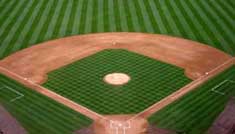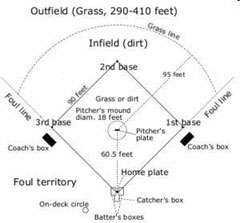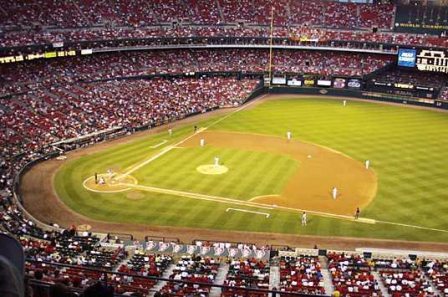
Field dimensions and diagrams for Little League, Softball, and Major Leagues
There are only 3 important sets of items on any baseball or softball field. The field dimensions vary, depending on the league in question.
 |
| Grass and dirt are not part of the field dimensions: they are only for the convenience of the players and viewing pleasure of the fans |
1. Four bases
- Home (or home plate, or the plate). Home is a flat, white, hard rubber plate embedded in the ground. The batter stands next to it as he tries to hit the baseball. He wants to advance around the other bases and return "home", thus scoring a run.
- First (base)
- Second (base)
- Third (base)
These three bases are square white bags that are secured to the ground. They are safe havens for offensive players trying to make the difficult journey from home and back to home. The distance between bases is 60 feet in most softball leagues and for Little League baseball. By the time players reach high school, they find the same field dimensions as Major Leaguers: 90 feet between bases.
 |
| Diagram 1: The Major League baseball field |
2. The rubber (officially, the "pitcher's plate")
It's on top of a mound of dirt almost in the middle of the diamond,
i.e., the area outlined by the four bases. The pitcher
has to have one foot touching the rubber when he delivers the ball
to his opponent, the batter. In Little League baseball,
the distance from the rubber to home plate is 46 feet. For high school, college, youth and professional leagues, the dimension is 60 feet, 6 inches. In softball, it ranges from 35 to 53 feet, depending on the league.
3. Two straight white lines (the foul
lines)
They extend from the outside edges of home plate, touching the outside
edges of, respectively, first and third bases. Each line continues
a lot farther, until it finally hits the wall that encloses the entire
field. A tall pole marks the spot where each one meets the wall.
Major League Baseball rules don't dictate the wall's dimensions or shape, so each baseball park has unique characteristics. As long as both lines are longer than a certain minimum, they can be—and usually are—of different lengths.The distance from each pole to home plate must be at least 325 feet. At the halfway point between the poles, the fence or wall must be at least 400 feet from home. These two rules apply only to fields built after 1957--some older ones are smaller.
The lines and the poles divide the field into fair and foul territories, which is of the utmost importance, because they have a lot to say about whether a baseball that is hit becomes a fair ball (maybe good for the offense) or a foul ball (almost never good for the offense). |
The following pages, using these dimensions and markings as a starting point, describe fair and foul territories and balls.



